About the Authors:
Renee Hudson received her BA in English at Stanford University and is currently a PhD student in English at UCLA. She specializes in twentieth century American literature. Her research interests include media theory, terrorism, and political violence.
Kimberly Knight is a doctoral candidate in Literature at UC Santa Barbara. Her research interests include literary and cultural theory; digital and information culture; new media literature and art; and twentieth century literature. She is currently writing her dissertation on viral structures in contemporary literature and new media. Knight is a member of the development team of The Agrippa Files: an Online Archive of Agrippa (a book of the dead) and has served as the RA for the Literature.Culture.Media (formerly Transcriptions) Studio at UCSB. She is also the Flash designer and co-author of the Transliteracies History of the Book project, “In the Beginning Was the Word”.
Popular Social Book Cataloging Sites
GoodReads
Created in 2006, Goodreads is a social networking site designed for booklovers. Accounts are linked to users’ email accounts, so friends can be added directly from one’s email account. Users receive updates through email about their friends’ activity on Goodreads. In addition to connecting with a user’s email account, Goodreads is also an application on Facebook. All reading updates have to be done through the Goodreads website, but afterwards Facebook users can refresh their Goodreads box, which will then show updated thumbnails of which books a user is currently reading and has already read. Facebook friends are automatically added as friends on Goodreads if both users have a Goodreads account.
The GoodReads Home Page:
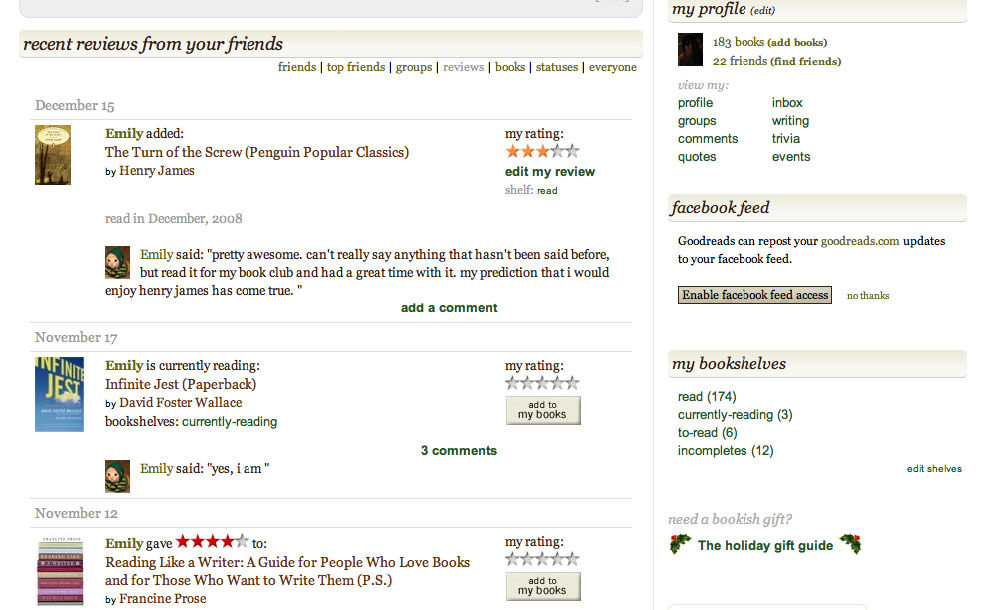
Goodreads User Bookshelf:
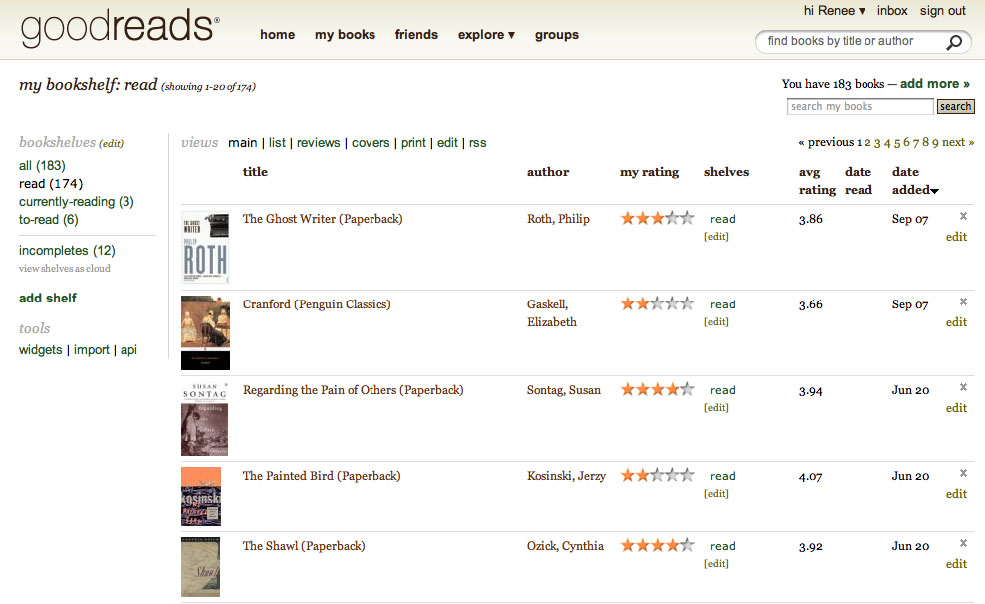
Visual Bookshelf
Visual Bookshelf is a Facebook application that utilizes the Amazon database while also allowing users to import books from their Amazon wishlist, ISBN number, or from LibraryThing. While Visual Bookshelf can exist solely as a Facebook application, it can also be integrated with the website Living Social:Books. Living Social:Books users can also link their account with their Bebo and Myspace sites. Visual Bookshelf and Living Social:Books allow users to embed information about their reading interests on other sites (like a user’s blog) with a few lines of code. Users are able to write reviews for other users to peruse in order to evaluate a book. When reading reviews, users have the ability to mark the review as either useful or not useful, thereby affecting the information other users receive about a book. Accessing a user’s profile provides a news feed whereby other users can see if a particular user has written a review, rated a book, or added more books to their collection. Looking at one’s home page reveals a news feed of information provided by LivingSocial about Visual Bookshelf as well as updated information about one’s Visual Bookshelf friends. In addition to writing reviews, users are given book recommendations based on their current bookshelves. These recommendations are improved for users by allowing them to select already read, want to read, reading now, or not interested next to each recommendation. From the recommendations tab, users can access either LivingSocial or amazon.com to continue their research and potential purchase of a particular book. Users can display their visual bookshelves on Facebook and opt to “show off” their favorite books by displaying them first. In addition to reviewing books and commenting on other user’s collections, users can create lists based on a categorization method of their own design. Users can also create wishlists, thus facilitating gift purchases. Managing one’s collection includes not only adding material, but also marking its status (already read, reading now) and whether or not one owns the book, wants it, does not want it, or has borrowed it. In this way, Visual Bookshelf not only records what books are in a collection, but also the degrees of possession a collector has to his or her collection.Visual Bookshelf in Facebook:
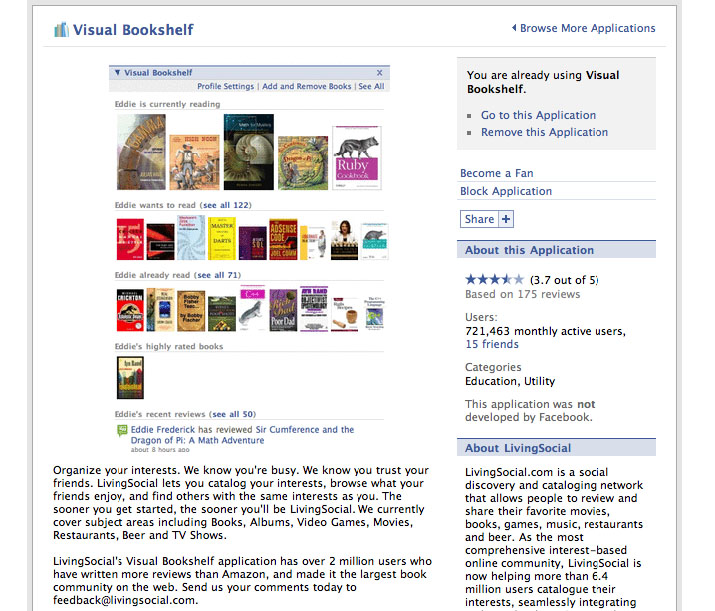
LibraryThing
Created in 2005 by Tim Spalding, LibraryThing is an online cataloging tool and a social networking site. Currently the “Zeitgeist” page lists 569,891 registered users and 34,052,446 cataloged books. Users, or “thingamabrarians,” add books to their personal libraries by simply entering the title, ISBN, author, or Library of Congress number into a search box. They have the option to search Amazon.com, The Library of Congress, or up to 78 other libraries worldwide. If a book is not found, users may input books manually, registering the ISBN, Library of Congress, or Dewey reference number. Once a search is entered, a list of books is returned and the user needs only to select the correct one to add it to his or her library. The user can add tags at the time she is conducting the search, or she may add them later.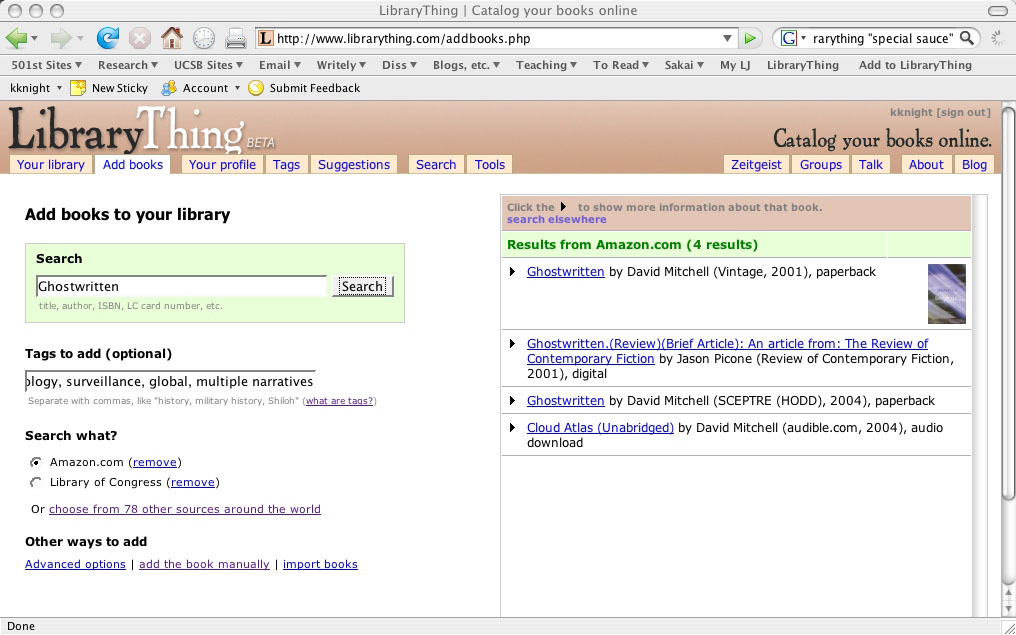
Once constructed, the user’s library can be viewed in “list view” and sorted by Title, Date of publication, Author, Tags, Rating, or number of other users who share the book. Alternatively, the library can be viewed in “cover view,” which mimics the look of books on a shelf.
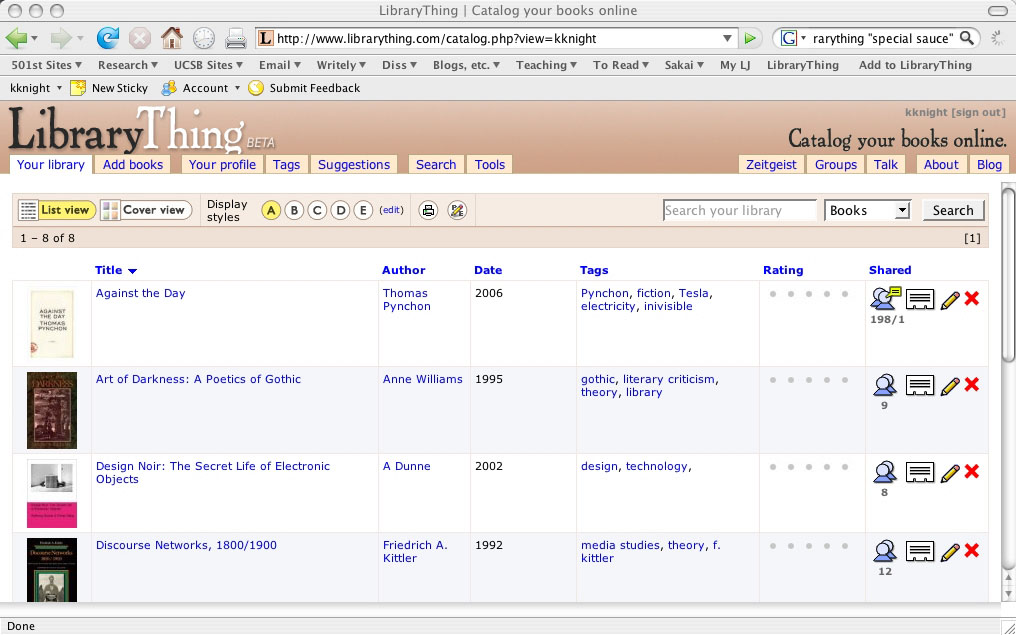
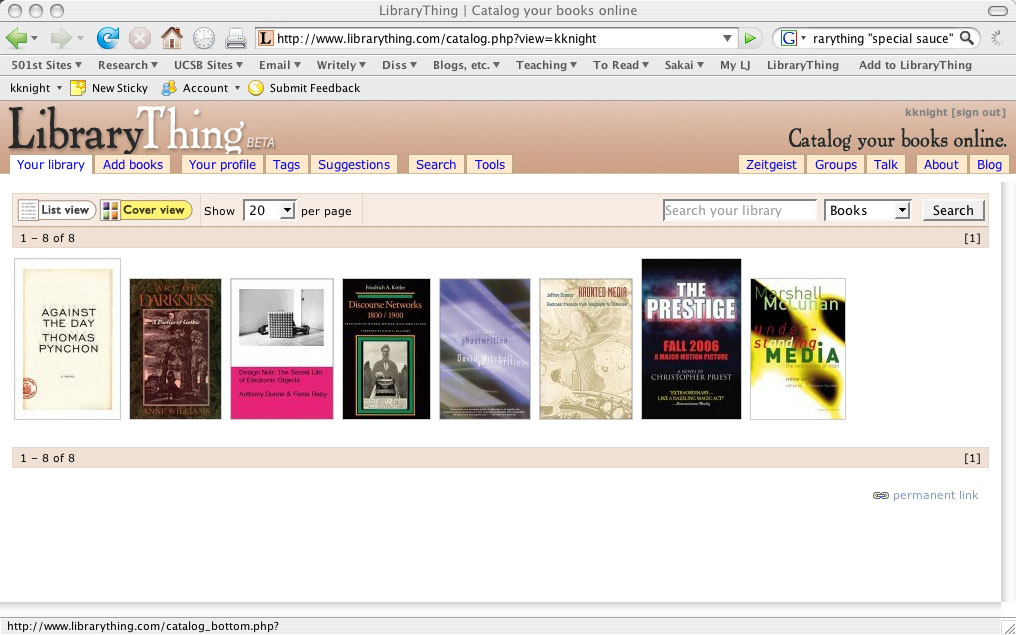
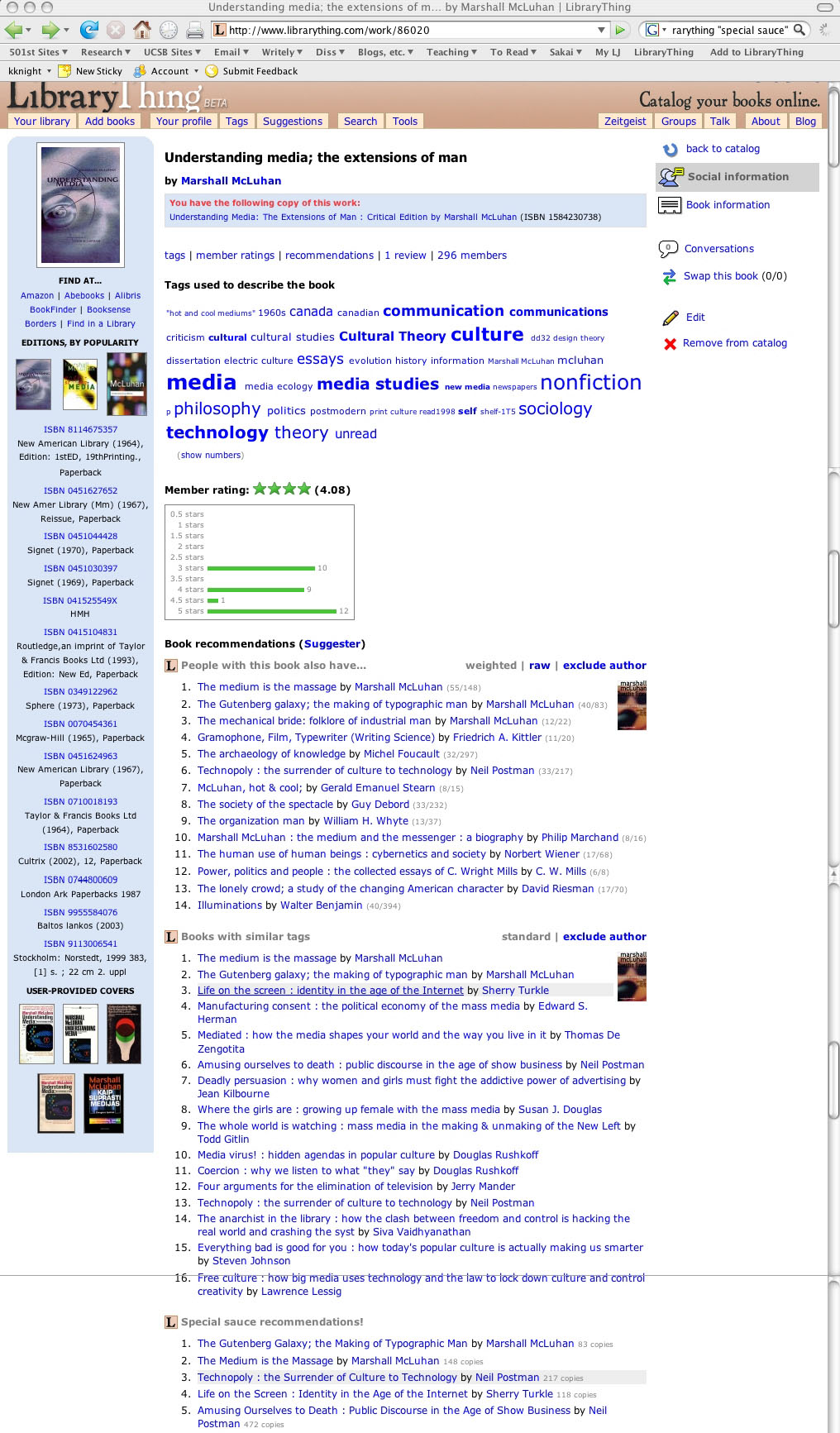
weRead
weRead was launched in early 2008 and is operated by Ugenie, Inc. The site seems to be supported by advertising banners at the top of each page. Like other book cataloging sites, weRead is connected to the Amazon.com database. It is also connected to the Online Computer Library Center, Google Book Search, and Lulu.com databases. Originally entitled “iRead,” weRead changed its name recently in order to emphasize its focus on the social aspects of book cataloging. On the site’s FAQ page, in response to a question regarding weRead’s “becoming more social,” the following is offered: “Over the next 8-12 weeks you will see many features that will answer this better. By social we mean that we will put your friends ratings, reviews, books, recommendations before everyone else. By Social we mean that you will be able to see and compare your book tastes with any of your friends” (http://weread.com/help.php). Currently, when one logs on to weRead’s site, one finds a list of current discussion board topics and reader activity. These activity posts are not connected to the user’s friends list or personal activity, but are instead a list of all activity recently engaged in by any user. The user may see what other users want to read, have recently read, or recently reviewed. However, once the user clicks on the “profile,” “my reads,” or “friends” tab that she is given any personalized information. The user’s “my reads” page tracks favorite books, books read, reviewed, and a wishlist of books the user wants to read. When entering books the user is given the option to check a box labeled “I own it” to indicate whether the book is in their physical possession or not.A User Profile:
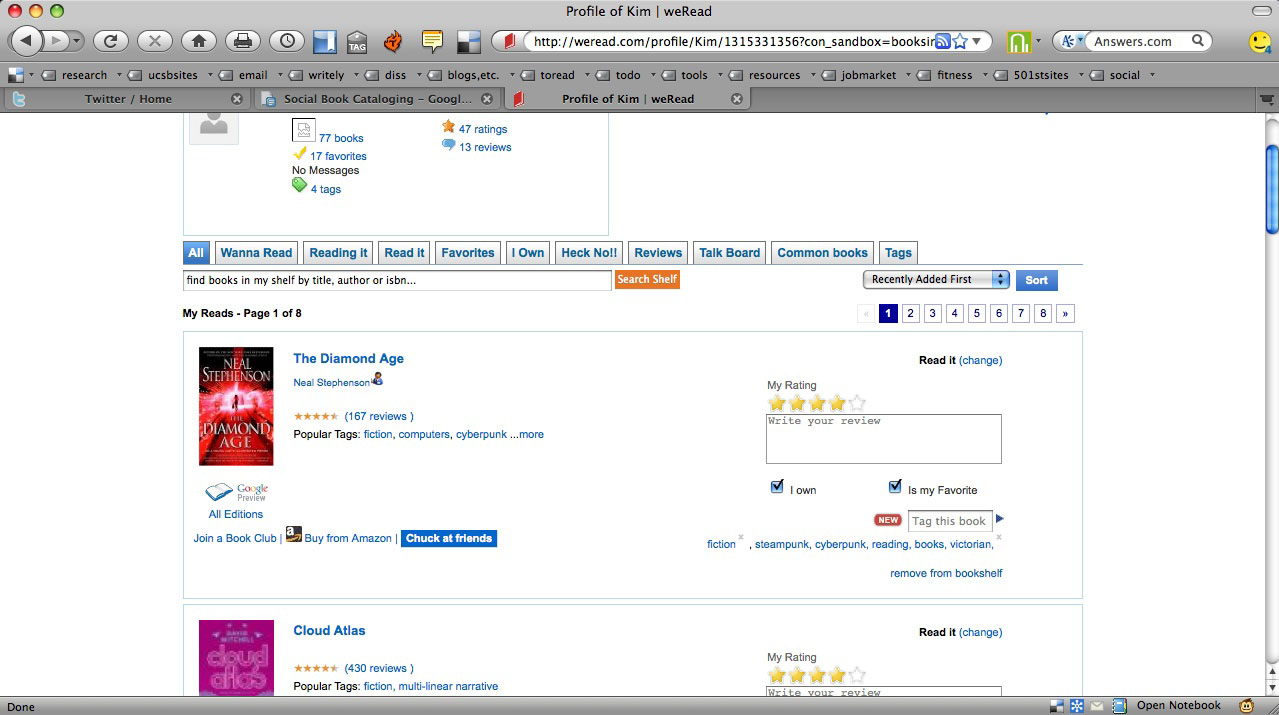
David Mitchell’s Author Profile:
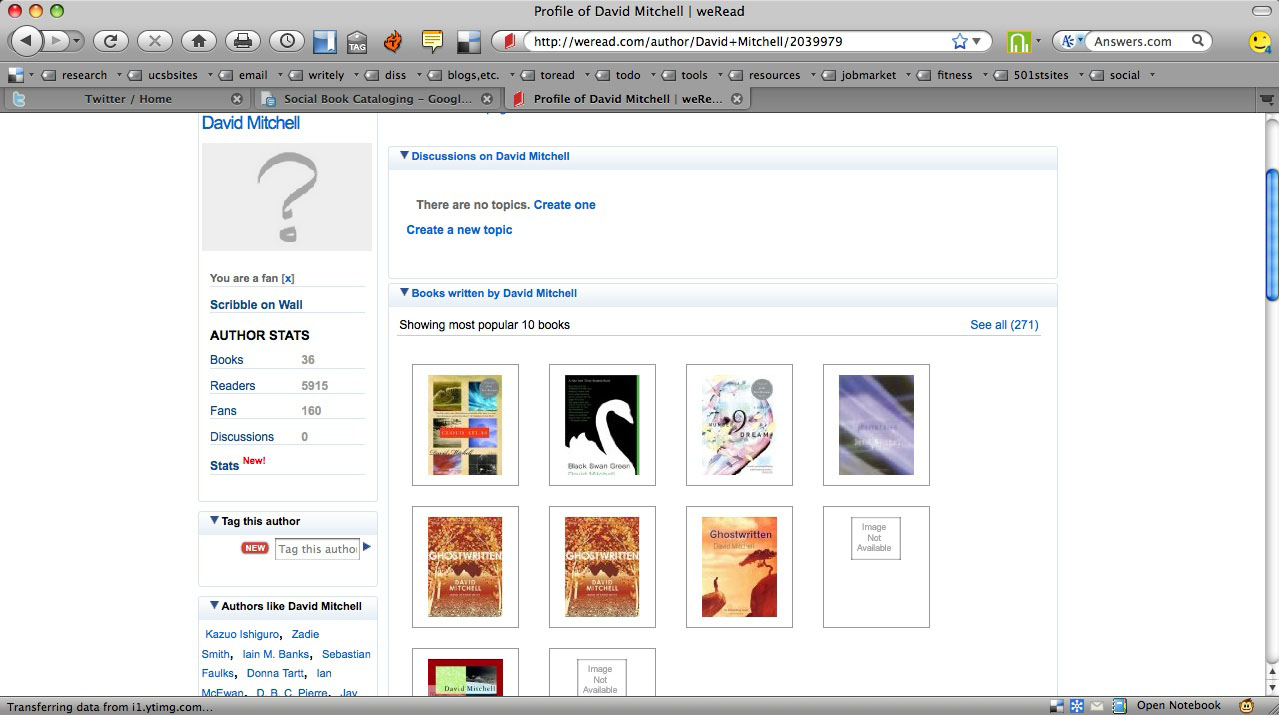
weRead, as displayed in Facebook:
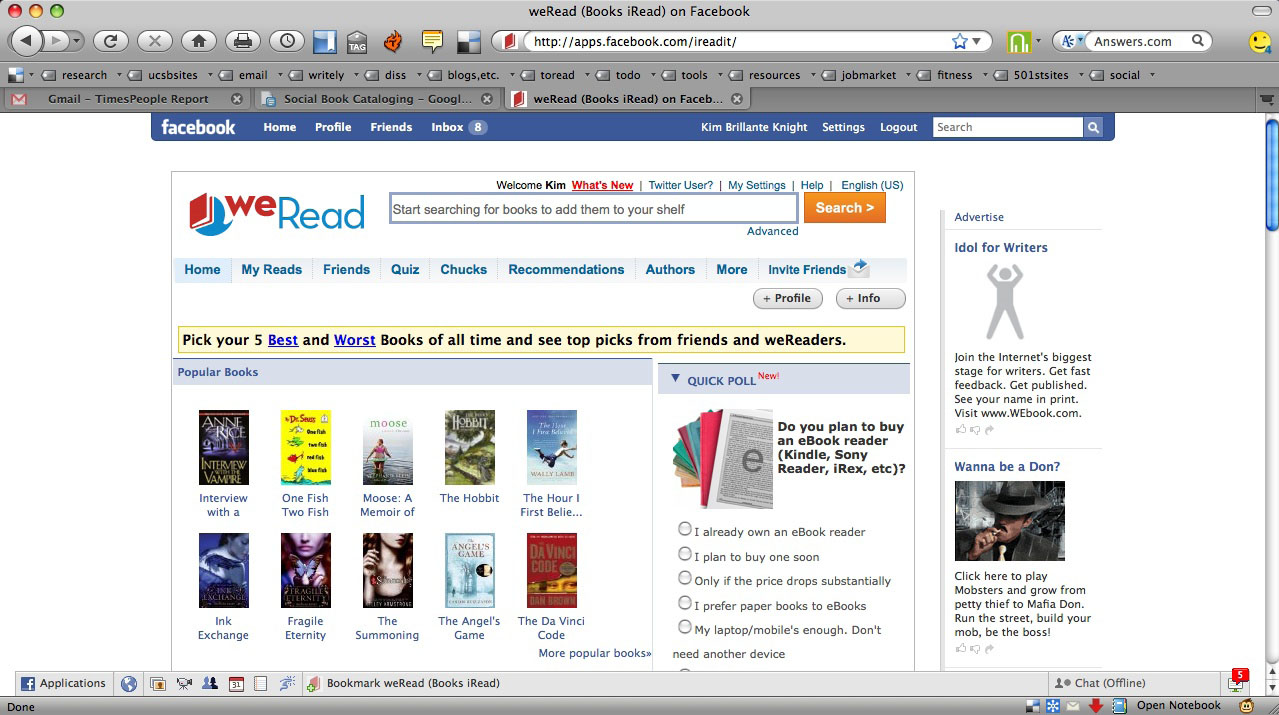
Cataloging
Defining the Catalog
Transition from Finding Tool to Marker of Human Experience
From “The” Catalog to Many Catalogs
Online book cataloging therefore abstracts the notion of cataloging by grounding it within individual experience rather than individual location, an institution, or items that are material possessions. Victoria Vesna describes the motivation to accumulate data as follows: “Collecting, storing, and archiving is very much connected to time, to our anxiety over the loss of time, and to the speed at which time travels. We preserve the all-important self in this age of relentless movement by creating a memory bank that testifies to our existence, to our unique contribution, and the promise to be brought back to life perhaps by someone in the future who can unpack the data and place it in a space of cultural importance” (25). The online book catalog enacts this preservation of self through the collecting, storing, and archiving of personal libraries. However, rather than hoping for a future reconstruction, the user testifies to her own existence and unique contribution in the present, by placing the catalog online in a social context, amongst a network of like-minded users. The catalog becomes less about access and more about constructing identity via connection. While focusing on a single medium and the record of an individual user may seem to make “the” catalog overly specific, the opposite occurs online. Rather than “the” catalog, users shift into the mentality of “a” catalog, where a multiplicity of records proliferates for each user to browse and enjoy. This multiplicity of catalogs interacts and facilitates connection such that catalogs emerge in a networked environment strengthened by meaningful connections between trusted friends rather than relying on information produced serendipitously by an algorithm. Online book cataloging tools take advantage of several databases for their material, including Amazon.com and ISBN numbers. In this way, social cataloging sites are able to incorporate “enriched” content that current library catalogs are unable to provide at present — “digitized tables of contents, cover art, reviews, summaries, and excerpts” (Tennant 33). Although social cataloging may not be the best way to do research, it does provide a more holistic view of the information available by providing details about the book in question and other users’ evaluations of that text. A better definition for the catalog as it is understood by social cataloging sites should then include the user’s role in contributing to the informational apparatus that accompanies each book: “a catalog is an account of books read and to-be-read by the user, along with discussion boards, reviews, rankings, and other enriched content.” In marking the shift from the catalog to a catalog, and from location to experience, there is then another shift that once again focuses on the role of the user — from passive browser to active participant in the corpus of information needed to evaluate material more thoroughly. Interestingly, then, the active role of the cataloger transforms the reader, whose activity is marked by leisure. Work become leisure in this environment. The act of reading, coupled with writing reviews, rating books, and socializing with friends in these communities is both a hobby and the information work that users do for themselves and others online. Channeling Benjamin, users work to encourage the inheritance and transmissibility of their collections:inheritance is the soundest way of acquiring a collection. For a collector’s attitude toward his possessions stems from an owner’s feeling of responsibility toward his property. Thus it is, in the highest sense, the attitude of an heir, and the most distinguished trait of a collection will always be its transmissibility (Benjamin 66).
The ability to catalog one’s reading experiences online and share them with others thus becomes a streamlined network of traffic between users in which transmissibility is actively sought and implemented. Transmissibility in this context thus transcends the physical artifact in favor of virtual representation by forming connections and communicating evaluative information between “friends.”
In redefining “the catalog,” then, it is not only the nature of the catalog that needs redefinition, but also the relationship between users and the catalog. This relationship ultimately determines the cultural and informational work done by the catalog. As Homi Bhabha reflects, referencing Benjamin:Does the order of books determine the order of things? What kind of history of oneself and one’s times is coded in the collecting of books? Driven by these thoughts, I was led to a somewhat unlikely, yet intriguing, reading of Benjamin’s concluding paragraphs. The inspired flâneur, you will remember, conjures of images of his wandering world through the cosmopolitan disorder and discovery of his old books . . . (Bhabha 5).
The order in which books are displayed in online catalogs is primarily determined by date added and date read, which makes the order of books inherently imprinted with one’s experience on it. Bhabha refers back to the reader-flâneur, who collects books around the world. Online environments bring together the urban reader-flâneur by encouraging users to write about their collections and the online reader-flâneur who, by participating in these communities and browsing other collections, wanders the site in search of an old favorite or a new discovery. The nature of finding and experiencing books has changed with social cataloging sites and it is this change that informs our new definition of a catalog.
The Persistence of Indexicality and the Limits of the Social Book Catalog
The newly redefined catalog requires one further level of consideration – it’s relationship to the database as an underlying structure of information. As noted earlier, previous conceptions of the catalog centered on the idea of a “finding list,” a list which was indexical in relation to a collection of physical objects. The social book catalog’s lack of attachment to a physical artifact allows a certain degree of freedom in relation to this older form of catalog. The ability of users to include books they do not own or have not yet read liberates the catalog from the physical artifact. However, the complex relationship between the user and the catalog refigures the function of the catalog as index – now it is also an index of the user. Christiane Paul writes, “The digital medium is not by nature visual, but always consists of a “back end” of algorithms and data sets that remain hidden and a visible “front end” that is experienced by the viewer / user, the latter being produced by the former” (97). In this case, the type of information allowed by the database produces the interface. None of the current social book catalogs allow a reader to document any reading experience other than a book. Because the cataloging sites connect to Amazon.com, the Library of Congress, etc., which are all organized around the concept of the “whole” book, users may not enter chapters, essays, journal articles, individual poems or plays, newspaper editorials, media texts, or web texts into their collection. This emphasis on the bound text not only limits what a user is allowed to enter, but it also establishes an artificial hierarchy which foregrounds “sustained” acts of reading of canonically produced material. One poem by Dickinson cannot be part of a catalog. Nor can a web-document, a painting, or an advertisement. Meaningful discourse around these texts will have to occur elsewhere. Immediately, the database of the book cataloging site is restricted by the nature of the database from which it draws its “enriched” content. In the case of the social book catalog, not only is the interface produced by the “back end,” but the user is “produced” by the combination of the back and front ends. Thus the user’s construction of self, via the construction of a catalog, is also limited. The reader’s list, organized by date read or date entered, is always necessarily incomplete. While it is naive to think that any person can by wholly and accurately represented by their online book catalog, the limitations of the database provide an additional set of constraints upon the attempt to capture or represent subjectivity. The items in a database are organized for fast search and retrieval (Manovich 2007 39). The books in a user’s collection are, in fact, shared amongst many users who list the same book – each catalog containing War and Peace, for example, refers back to the same database entry. The archive, which preserves the “all-important self” (Vesna 25) is not a unique marker of identity, but a shared resource. Manuell Castells notes the tendency for the internet to produce a conflict between the “net and the self” most notably in the contrast, noted by Raymond Barlow, between ability of information systems and networking to “augment human powers of organization and integration while subverting the Western concept of the independent subject” (Castells 23). The construction of the independent user via the catalog masks the ways in which that individuality is in fact grounded in the collective identity of databases such as Amazon.com and the Library of Congress. Thus the interface, which facilitates the flâneur experience, masks the role of the database in the construction of the user. This “front end” calls up the representation of the user each time the individual catalog is accessed and is always determined by the limitations and organization of the underlying database.Performative Aspects of the Catalog
As noted in the previous section, online social cataloging sites highlight the role of the user as an online reader-flâneur, who experiences reading in its various manifestations in these communities. Fundamentally, the reader-flâneur does not just browse collections and find books, but plays the double role of active participant on these sites. A user’s reading experience becomes a public, performed act, which is yet another way a user constructs his or her identity online. Looking simply at one of these sites, like Goodreads.com, a user’s identity is based primarily on book selection and the textual apparatus a user has created to supplement that selection. Seen in this way, a user is judged based on reviews and discussion boards as well as the nature of his or her collection. Books within a user’s collection serve to mark the identity of the user — for instance, a user who lists several books on pregnancy or child-raising highlights his or her role as a parent while a user who adds books on Henry James and Marcel Proust marks his or her identity as a reader of high-brow literature. However, when a user chooses to integrate a site like Goodreads.com with another social networking site like facebook.com, the Goodreads.com identity is no longer the primary construct, but a part of the facebook identity. Reading factors into online identity construction, but is not the sole determining element that defines users online when part of a larger social networking site. At the same time that a user’s online social cataloging identity is part of a larger online presence, depending on preferences, the social cataloging identity can have more or less prominence than other applications that form the facebook profile. In this way, the amount of virtual space dedicated to a site like Goodreads.com (no box, a box, a tab) marks the Goodreads identity as one with more or less prominence in comparison to other factors of identity construction like favorite movies, restaurant reviews, and photo albums. Significantly, whether a user chooses to access Goodreads or facebook with a Goodreads application, such a user chooses to perform at least some aspect of his or her identity on book cataloging in a socially networked environment. Book selection can help users find new friends based on their collections while also identifying one’s current friends as having similar or vastly different reading interests. The decision to add a book, write a review, and / or rate the book all become part of how a user chooses to construct his or her identity. From how-to books to guilty pleasures to high-brow literature, each addition provides a more holistic view of the user participating in these selections. A catalog, deeply embedded in an individual user’s experience, also becomes an integral factor in fashioning that user.Reading the Catalog
If a user is to construct his or her identity through the compilation of an online catalog of her books, it stands to reason that this catalog must be made meaningful in some way. The other users must recognize from the catalog the cues of identity and assemble them into a holistic “picture” of the user. To read, or to make meaning through the act of interpreting characters or symbols (Oxford Dictionary of English, 2nd ed.), is one of the most familiar ways to conceptualize the making of meaning from another user’s catalog. Text was the earliest form to be made digital, and as such, many have speculated on the linkages between the format of the printed page and the organization of web pages (Manovich, Language 72). Additionally, artists and theorists such as Giselle Beiguelman, Espen Aarseth, and J. Yellowless Douglas, have speculated on the impact of the Internet on the idea of the book and the library, as well as practices of reading. However, in considering reading the catalog, it will be most useful to think about reading in relation to databases. Manovich positions narrative as just one means of accessing data among many others, and he argues that narrative and database are fundamentally at odds (“Database” 41). In contrast, Christiane Paul writes, “However, databases do lend themselves to a categorization of information and narratives that can then be filtered to create meta-narratives about the construction and cultural specifics of the original material” (101). She refers to TextARC as a paradigmatic example of a database about which one may construct a meta-narrative. While this is not narrative in the traditional sense of “story,” Paul’s argument for meta-narrative acknowledges that the database may be “read” and that the discrete pieces can be assembled into a larger statement of meaning. It is Grahame Weinbren, however, who argues for the expressive potential of the database. He writes, “the idea that there might be an expressive potential to interactivity, that we might be able to use interactivity to represent our worlds, interior and exterior, in ways not before possible has been passed by, largely unexplored” (68). In this case he refers to the Internet as one large database and wishes to conceptualize interactivity beyond the hypertext link. As we argued above, the user constructs the social book catalog as that very expression of his or her interior and exterior worlds. And while the collection of books may not themselves form a narrative, it is possible to “read” them together and form a meta-narrative about the user whose collection is under review. Although Manovich argues that the web operates according to a logic of anti-narrative (“Database” 41), he later writes, “the database of choices from which narrative is constructed (the paradigm) is implicit, while the actual narrative (the syntagm) is explicit. New media reverses this relationship. Database (the paradigm) is given material existence, while narrative (the syntagm) is dematerialized. Paradigm is privileged; syntagm is downplayed. Paradigm is real; syntagm is virtual” (“Database” 49). While it is true that paradigm is privileged in the social book catalog and that syntagm is made virtual, this does not mean that syntagm is non-existent. The syntagm exists, waiting for a willing reader to construct the meta-narrative. Social book cataloging utilities tend to employ various strategies for representing data that assist readers in constructing this meta-narrative. In addition to lists of texts, the data is often represented in visual forms with cover art, tag clouds, visual rating systems, etc. Data is also organized in multiple ways – in lists, on “bookshelves”, by common tags, etc. Thus users may approach “reading the catalog” using the multimedia strategies that are necessary for digital literacy. The multimedia components and alternative methods of organization further humanize the data from which the user constructs her identity and provides “readers” with a catalog composed of materials that are already familiar in the online context. Additionally, “the” catalog, which is actually comprised of many catalogs, may be read at different scales. In addition to reading single user catalogs, a collective catalog may be read in order to discern meaning and construct meta-narratives about current trends in reading. (For more on reading the catalog at different scales, see the “Reading as Networking as Reading” section)Reading Beyond the Catalog
By redefining a catalog in terms of a collection specifically for books in which a user contributes enriched content, the relationship between catalog and user, as noted above, has been fundamentally changed. When looking for information, users no longer flip through printed catalogs or look through a card catalog — they look for information online and require enriched content, often in the form of detailed textual apparatus, to evaluate their choices and engage with the books they read. A book’s rating, the nature of its reviews, and its role as the topic of a discussion board, all contribute to users reading beyond a catalog for not only more information, but also for more opportunities to delve into a specific text. A sampling of reviews reveals the personal relationship between the reader and the text. From an anecdote about why a reviewer read a particular book to how a book reminded him or her of a personal experience, the reviews unmask how users read and process texts. Other reviews summarize the contents of a book, giving potential readers a clearer idea of what to expect from that book should s/he choose to read it. Still other reviews focus on the experience of reading a book and how the book has affected them. Overall, the reviews provide a candid snapshot of a book for other users to utilize when evaluating their own reading material. Users are also able to write comments on a review, which opens up an online dialog in much the same way discussion forums do. In these discussion threads (there can be several for each book), users pose questions or solicit information from other users. Rather than merely writing about a book or reading about it, then, users are able to engage with others online to discuss texts and clarify anything that was confusing in a particular book. Recommendations and rating systems provide users with the opportunity to find books they might enjoy based on their own reading lists while also quantifying information about a book for a cursory review of that book. In this way, rather than skimming through a printed catalog that may list works in alphabetical order by author, users can access books that are in a similar vein, but which might exist at a remove in the catalog, depending on organization. By looking at the number of reviews and the average rating, users have a basis from which to judge whether or not they will also enjoy or not like a book. News feeds and newsletters provide information on books, authors, and friend activity on these sites. Users are thus able to enhance their own online experiences, while simultaneously being exposed to fresh suggestions. Reading beyond the catalog thus includes reading a variety of materials that will allow a user to read books outside of his or her own interests; reading beyond the catalog is not simply confined to the textual apparatus these sites provide. Significantly, reading beyond the catalog involves writing beyond the catalog. Without user participation in reviews, rating systems and discussion boards, the enriched content provided by these sites would not exist. Without the creators of these sites writing newsletters and email updates while creating features like recommendations and forums, users would not have access to as much new information. Even more importantly, they would not have the outlets needed to read and write about books in order to synthesize their experiences as readers. The online catalogs on these sites create a living document that is constantly under construction as users continue to read and evaluate their experiences.Networking as Reading as Networking
In Discourse Networks, Friedrich Kittler writes, “All libraries are discourse networks, but all discourse networks are not books” (369). One might think of the collection of social book cataloging utilities as forming one amorphous discourse network. Each utility functions as part of a “network of technologies and institutions that allow a given culture to select, store, and process relevant data” (Kittler 369). To this end, the more general social networking sites, such as Facebook or MySpace, are also an important part of this discourse network. The discourse network, in any of its forms, is constructed of the subjects whose practices are shaped by it. In reference to early internet communities, Mark Poster writes, “many areas of the Internet extend preexisting identities and institutions” (266). In the case of social book cataloging, the pre-existing identities are those of readers. By joining a site or installing a Facebook application, a subject is first and foremost declaring him or herself a “reader.” The user may then, as noted above, begin to narrow and customize that subject position into a particular type of reader. This online identity extends the pre-existing networks of readers that operate concurrently through book clubs, libraries, book shops, and classrooms. Historians of the book might argue that reading has always been a type of networked activity – from early acts of public readings of sacred texts, to reading aloud at the domestic fireside, etc. Thus, rather than thinking of the utilities as forming a discourse network, we may be better served by thinking of what these technologies add to the already-existing network. The culture of readers uses these sites to construct themselves as readers and to connect to other readers. Certainly, social book cataloging utilities offer readers one more way in which to discuss books. Beyond being just another forum for discussion, the often uni-directional act of cataloging books, in which one lists books, awards stars, and writes reviews, without comment or feedback from other readers, provides the reader with an occasion for expression that may go unanswered. In contrast to a classroom or a book club, where there may be a linear dialogue happening in real time, the book cataloging utility re-figures the timeliness of the reading discourse. A user may write a review that sits for months before one of their contacts happens to read it or respond to it, shifting the dialogic nature of reading discourse. In addition, enabled by the Internet, these utilities allow readers to make connections across geographic spaces that may have been previously more difficult to cross. A secondary, perhaps unintentional, result of book cataloging sites is that they are collectively assembling information about readers and reading habits, supplementing information that was previously available only through the statistics of publishers, libraries, and book-sellers.. For instance, a cursory glance at the rankings of books on each site tells us that the entire Harry Potter series of books by J.K. Rowling remain amongst the most commonly owned, most frequently reviewed, and most highly rated of the millions of books cataloged on each site. In the Introduction to Database Aesthetics, Victoria Vesna writes, “data are the raw forms that are shaped and used to build architectures of knowledge exchange and serve also as an active commentary on the environment they depend on—the vast, intricate network with its many faces (xiii). This additional user-created data creates a sort of folksonomical commentary on the reading network. In these ways, the cataloging utility re-shapes the nature of information and discourses about books. And finally, by allowing the reader to construct his or her own catalog, the utility offers a summary of a user’s reading identity that may not have been visible when discussing books on a one-by-one basis. This may be one of the most unique features of the social cataloging utility. As Manuel Castells writes of network society, “in a period where there is widespread destructuring of organizations and delegitimation of institutions, fading away of major social movements and ephemeral cultural expressions, identity becomes the major, sometimes only, source of meaning” (3). Thus the social book cataloging utility makes its most meaningful contribution to the network in the self-conscious and visible construction of reading identities.Integration of Book Cataloging into Other Social Networking Sites
Among other social networking sites, several of the social book cataloging tools can be integrated into both Facebook and MySpace. The ability to integrate allows for a wider audience for social catalogs while also privileging social networking over social cataloging. As a widget on Facebook for example, Goodreads users who add the application market Goodreads by making the application visible to others. Integration is the key to viability for social catalogs since it allows users to centralize their social networking tools rather than access multiple sites for different functionalities. At the same time that integration allows for the viability of social catalogs in general, the mere fact that social cataloging becomes an application on another site illustrates social catalogs’ dependence on larger social networking sites. After all, a Goodreads user does not add a Facebook application to their Goodreads profile — it is always the other way around. However, some sites, like Goodreads, force users to access the actual website to update their information while other sites, like Visual Bookshelf, allow users to make changes directly from their Facebook account. Either way, cataloging is only one component of an online identity and, while a site may replicate social networking centered around cataloging, it is the network that matters the most, the relationships forged between users on these sites. An illustration of this is the disparity in the number of users for the various book cataloging sites. LibraryThing (700,000+ users) does not offer any MySpace of Facebook integration on their site, though they do offer a blog widget and APIs. In contrast, WeRead (3,000,000+ users) Goodreads (2,000,000+ users), and Visual Bookshelf (6,000,000+ LivingSocial users) all offer integration with the more social networking sites such as Facebook or MySpace. The cataloging utilities which are integrated with pre-existing social networks draw more users than LibraryThing, despite LibraryThing’s robust set of tools.Reflections on Social Book Cataloging in relation to the Transliteracies Bluesky PRoSE System
In many ways the current plans for the PRoSE system, in partnership with the ETCL PReE system and the REKn database, will function as a social cataloging system. However, by registering as a member of PRoSE a user is not only declaring himself a “reader,” but also already narrowing that category somewhat to “professional reader.” Depending upon the databases with which the system will work, this identity may be further narrowed to “professional reader of early modern studies,” etc. Much like social book cataloging utilities allow users to define their reading experiences, PRoSE will allow users to define their professional reading experiences and to connect those experiences with other users. Just as the various social cataloging utilities are constrained by the databases from which they pull information, so too will PRoSE be fundamentally constructed through the type of databases with which it partners through PReE. If it is possible in the development, PRoSE has the opportunity to offer something unique if the database and interface can be constructed to allow users to interact around a rich variety of “document” types and to enter their own meaningful objects into the system. For instance, we know that there are already plans in place to connect (through PReE) with REKn, the Renaissance English Knowledgebase, which contains material in multiple media forms, both primary and secondary. Earlier, we wrote “Thus, online book cataloging abstracts the notion of cataloging by grounding it within individual experience rather than individual location, an institution, or items that are material possessions” (Defining the Catalog section). In its association with pre-existing institutional databases, PReE / PRoSE will re-moor the catalog to the institutional database. However, what if one of PRoSE’s users should find a particularly salient article not contained in the database? Or come across a television special on a related topic, about which this user would like to make notes and have a discussion? It seems that one of the ways that PReE / PRoSE can be most useful to professional readers is in giving them the flexibility to catalog as much of their professional reading experience as they find meaningful and necessary. This would also allow PReE / PRoSE to widen its audience beyond the audience typically captured by the databases to which it will be connected. If PReE / PRoSE had a clipping or notebook type tool, along the lines of Clipmark or Google Notebook, users could register meaningful content in the system while falling within fair use guidelines. The PReE / PRoSE developers might also think of other ways of registering meaningful content, such as by allowing RSS feeds of del.icio.us or digg bookmarks to display on user profiles, etc. As noted above, most online social networks extend pre-existing social identities onto the internet. There is, however, some room for the construction of identity through the construction of cataloged materials. It is likely that PRoSE will allow the same sort of self-positioning; however, the user’s identity as professional reader will always be constrained by the already existing hierarchies of the academic network. In fact, the PRoSE system, in its current incarnation, makes these hierarchies visible by expanding the notion of the “contact” or “friend” to include multiple types of relationships such as faculty, colleague, rival, etc. One could certainly argue that these relationships represent the network of professional readership more accurately and dispel with the superficial “flattening” of relationships offered through other social networking sites. This argument foregrounds the enduring presence of hierarchies, even in supposedly democratic, liberating spaces. As such, PRoSE ought to be constructed with tools and features that allow for rich interaction in a networked situation that is inescapably hierarchical. For instance, users ought to be able to determine different levels of access to their profile information as well as to their collection of documents, annotations, etc. This could be accomplished with customizable user-defined groups or with the ability to assign levels of access based on types of relationships. The presence of “historical figures” in PRoSE is an exciting refiguring of the “favorite authors” function in many of the social book cataloging utilities. In order to maximize the singularity of this feature, it will be important for the system to extend functionality beyond that of the existing social book cataloging utilities, i.e. to do something more “interesting” than display bio pages. There are many potential uses for this feature, such as visualizations of complex relationships. If PRoSE could partner with TAPOR or Many Eyes or perhaps even develop native tools that would allow users to visualize relationships in multiple formats (chronologically, by keyword, geographically, etc.), the system would offer a valuable function that is currently not found elsewhere. This also raises the question of which other existing tool sets could PRoSE utilize / partner with in order to extend the functionality of the system? Although professional readers may have different requirements from the users on social book cataloging sites, it is still important to consider the question raised by Victoria Vesna in Database Aesthetics, “how does one represent the information without dehumanizing it?” (xi). Images of book covers and “star” rating systems may be too informal for a system in which users are constructing their professional identity; however, these features remind us of the importance of visual elements and a “friendly” user-interface. While many of PRoSE’s target audience are accustomed to conducting research with digital tools, for some this may be the first foray into a structured social networking system. Thus as the system develops, an ongoing consideration of the interface will be critical to PRoSE’s success. Additionally, the developers might keep Weinbren’s enthusiasm for the expressive possibilities of the database in mind as they consider the features upon which they will focus their resources.Bibliography
- Bhabha, Homi. “Unpacking my Library Again.” The Journal of the Midwest Modern Language Association 28 (1995): 5-18.
- Benjamin, Walter. “Unpacking my Library.” Illuminations, ed. Hannah Arendt. New York: Schocken Books, 1968.
- Castells, Manuel. The Rise of the Network Society. Oxford: Blackwell Publishing, 2006.
- Freedman, Maurice J. and S. Michael Malinconico, eds. The Nature and Future of the Catalog: Proceedings of the ALA’s Information Science and Automation Division’s 1975 and 1977 Institutes on the Catalog. Phoenix: Oryx Press, 1979.
- “Goodreads.” Goodreads.com, 29 June 2009. Web. 29 June 2009.
- Kittler, Friedrich. Discourse Networks 1800/1900. Palo Alto: Stanford UP, 1992.
- “LibraryThing.” Librarything.com, 21 June 2009. Web. 21 June 2009.
- “Living Social: Books.” Livingsocial.com, 15 June 2009. Web. 15 June 2009.
- Malinconico, S. Michael. The Future of the Catalog: The Library’s Choices. New York: Knowledge Industry Publications, Inc., 1979.
- Manovich, Lev. The Language of New Media. Cambridge: MIT Press, 2002.
- Manovich, Lev. “Database as Symbolic Form.” Vesna 39 – 60.
- Paul, Christiane. “The Database as System and Cultural Form: Anatomies of Cultural Narratives.” Vesna 95 – 109.
- Poster, Mark. “Cyberdemocracy: The Internet and the Public Sphere.” Reading Digital Culture. Ed. David Trend. Oxford: Blackwell Publishers, 2001.
- Professional Reading Environment (PReE). Electronic Textual Cultures Lab (ETCL). University of Victoria. 05 June 2009.
- Renaissance English Knowledgebase (REKn). Electronic Textual Cultures Lab (ETCL). University of Victoria. 05 June 2009.
- Stone, Allucquére Rosanne. “Will the Real Body Please Stand Up?: Boundary Stories about Virtual Cultures.” Reading Digital Culture. Ed. David Trend. Oxford: Blackwell Publishers, 2001.
- Tennant, Roy. “Demise of the Local Catalog.” Library Journal 132 (2007): 26.
- Tennant, Roy. “Enriching the Catalog.” Library Journal 129 (2004): 33.
- Tennant, Roy. “21st Century Cataloging.” Library Journal 123 (1998): 30-31.
- Vesna, Victoria. “Seeing the World in a Grain of Sand.” Vesna 3 – 38.
- Vesna, Victoria, Ed. Database Aesthetics: Art in the Age of Information Overflow. Minneapolis: U of Minnesota P, 2007.
- “Visual Bookshelf.” Facebook.com. 1 June 2009. Web. 1 June 2009.
- Weinbren, Grahame. “Ocean, Database, Recut.” Vesna 61 – 85.
- “weRead.” weRead.com, 3 June 2009. Web. 3 June 2009.

